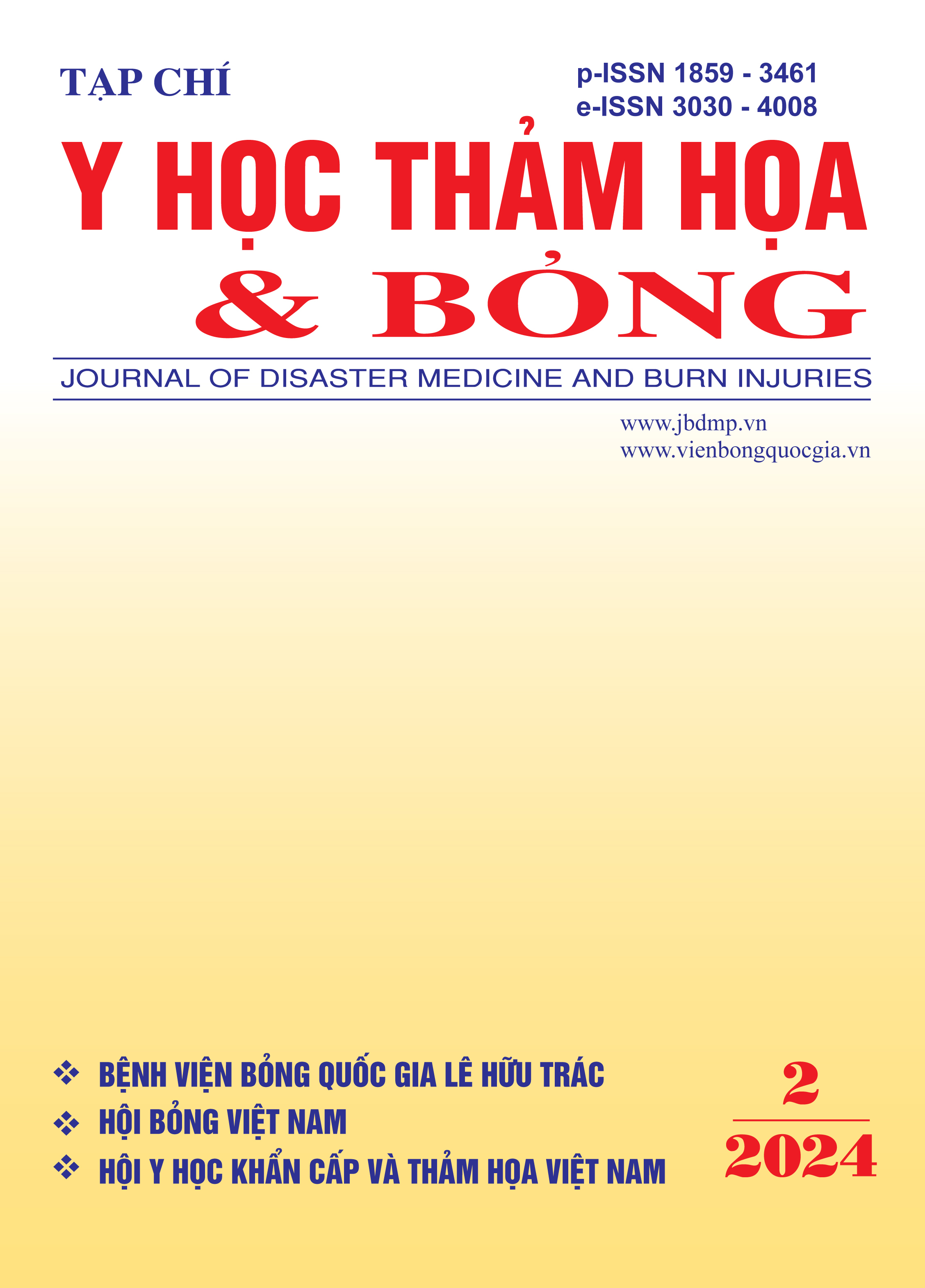Clinical report of a severe inhalation injury patient
Main Article Content
Abstract
Inhalation injury caused airway damage, hypoxia, increased the risk of death by 20%, and was independently associated with mortality in severe burn patients. Treatment of Inhalation injury remains challenging for clinicians. We report a case of severe inhalation injury, carbon monoxide poisoning treated at the Intensive Care Unit (ICU), Le Huu Trac National Burn Hospital.
Article Details
Keywords
Inhalation injury, nebulized, endoscopic bronchoscopy
References
1. Goh CT, Jacobe S (2016). Ventilation strategies in paediatric inhalation injury. Paediatric respiratory reviews, 20:3-9.
2. Jones SW, Williams FN, Cairns BA, Cartotto R (2017). Inhalation injury: pathophysiology, diagnosis, and treatment. Clinics in plastic surgery, 44(3):505-511.
3. Cuthbertson D (1942). Post-shock metabolic response. The Lancet, 239(6189):433-437.
4. Sterner JB, Zanders TB, Morris MJ, Cancio LC (2009). Inflammatory mediators in smoke inhalation injury. Inflammation & Allergy-Drug Targets (Formerly Current Drug Targets-Inflammation & Allergy)(Discontinued), 8(1):63-69.
5. Barrow RE, Spies M, Barrow LN, Herndon DN (2004). Influence of demographics and inhalation injury on burn mortality in children. Burns, 30(1):72-77.
6. Reid A, Ha JF (2019). Inhalational injury and the larynx: A review. Burns, 45(6):1266-1274.
7. Romanowski KS, Palmieri TL, Sen S, Greenhalgh DG (2016). More than one-third of intubations in patients transferred to burn centers are unnecessary: proposed guidelines for appropriate intubation of the burn patient. Journal of burn care & research, 37(5):e409-e414.
8. Dries DJ, Endorf FW (2013). Inhalation injury: epidemiology, pathology, treatment strategies. Scandinavian journal of trauma, resuscitation and emergency medicine, 21:1-15.
9. Marek K, Piotr W, Stanisław S, Stefan G, Justyna G, Mariusz N, Andriessen A (2007) Fibreoptic bronchoscopy in routine clinical practice in confirming the diagnosis and treatment of inhalation burns. Burns, 33(5):554-560.
10. Bittner EA, Shank E, Woodson L, Martyn JJ (2015). Acute and perioperative care of the burn-injured patient. Anesthesiology, 122(2):448-464.
11. Saffle JR, Morris SE, Edelman L (2002). Early tracheostomy does not improve outcomes in burn patients. The Journal of burn care & rehabilitation, 23(6):431-438.
12. Holt J, Saffle JR, Morris SE, Cochran A (2008). Use of inhaled Heparin/N-acetylcysteine in inhalation injury: does it help? Journal of burn care & research, 29(1):192-195.
2. Jones SW, Williams FN, Cairns BA, Cartotto R (2017). Inhalation injury: pathophysiology, diagnosis, and treatment. Clinics in plastic surgery, 44(3):505-511.
3. Cuthbertson D (1942). Post-shock metabolic response. The Lancet, 239(6189):433-437.
4. Sterner JB, Zanders TB, Morris MJ, Cancio LC (2009). Inflammatory mediators in smoke inhalation injury. Inflammation & Allergy-Drug Targets (Formerly Current Drug Targets-Inflammation & Allergy)(Discontinued), 8(1):63-69.
5. Barrow RE, Spies M, Barrow LN, Herndon DN (2004). Influence of demographics and inhalation injury on burn mortality in children. Burns, 30(1):72-77.
6. Reid A, Ha JF (2019). Inhalational injury and the larynx: A review. Burns, 45(6):1266-1274.
7. Romanowski KS, Palmieri TL, Sen S, Greenhalgh DG (2016). More than one-third of intubations in patients transferred to burn centers are unnecessary: proposed guidelines for appropriate intubation of the burn patient. Journal of burn care & research, 37(5):e409-e414.
8. Dries DJ, Endorf FW (2013). Inhalation injury: epidemiology, pathology, treatment strategies. Scandinavian journal of trauma, resuscitation and emergency medicine, 21:1-15.
9. Marek K, Piotr W, Stanisław S, Stefan G, Justyna G, Mariusz N, Andriessen A (2007) Fibreoptic bronchoscopy in routine clinical practice in confirming the diagnosis and treatment of inhalation burns. Burns, 33(5):554-560.
10. Bittner EA, Shank E, Woodson L, Martyn JJ (2015). Acute and perioperative care of the burn-injured patient. Anesthesiology, 122(2):448-464.
11. Saffle JR, Morris SE, Edelman L (2002). Early tracheostomy does not improve outcomes in burn patients. The Journal of burn care & rehabilitation, 23(6):431-438.
12. Holt J, Saffle JR, Morris SE, Cochran A (2008). Use of inhaled Heparin/N-acetylcysteine in inhalation injury: does it help? Journal of burn care & research, 29(1):192-195.


